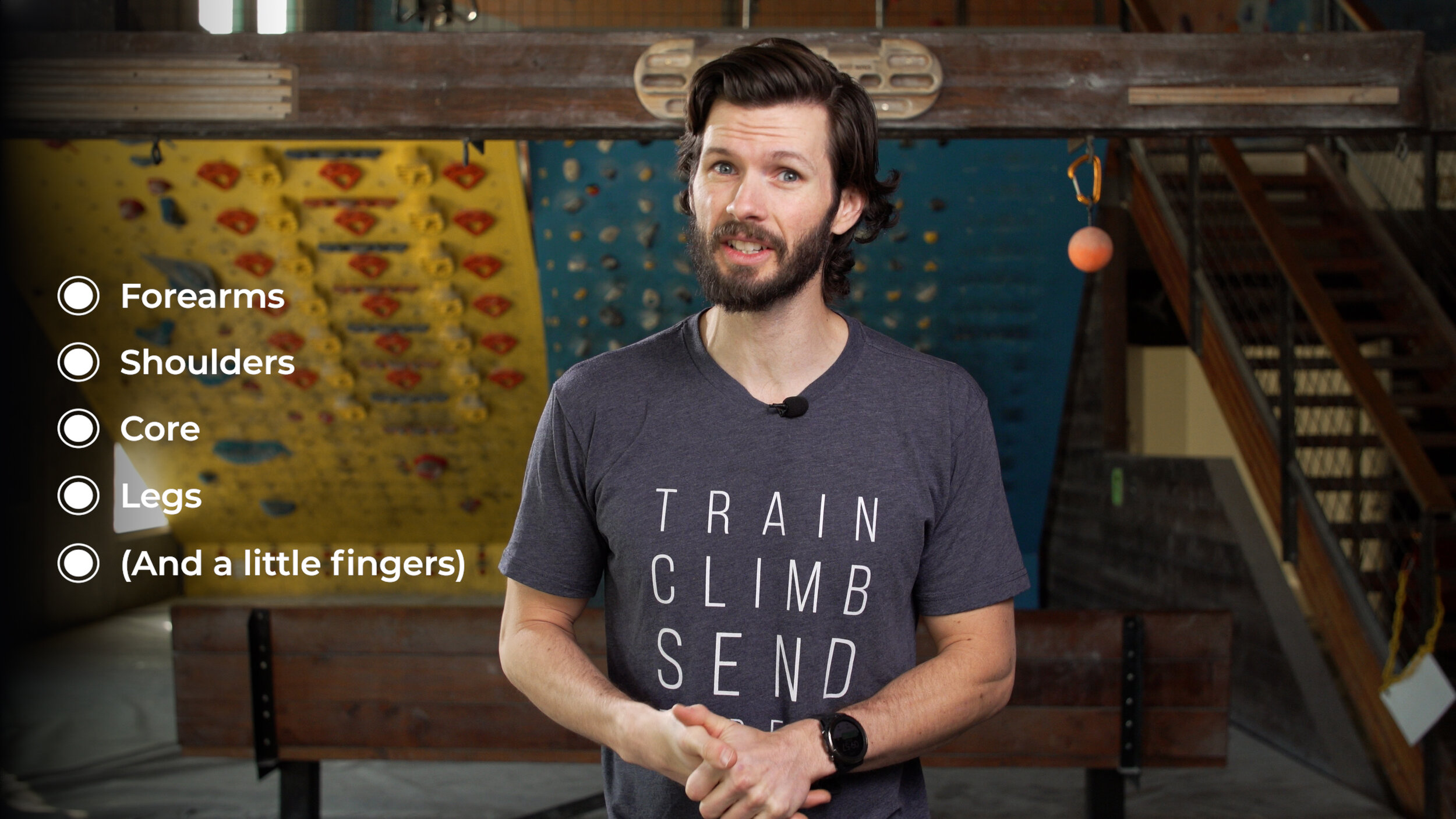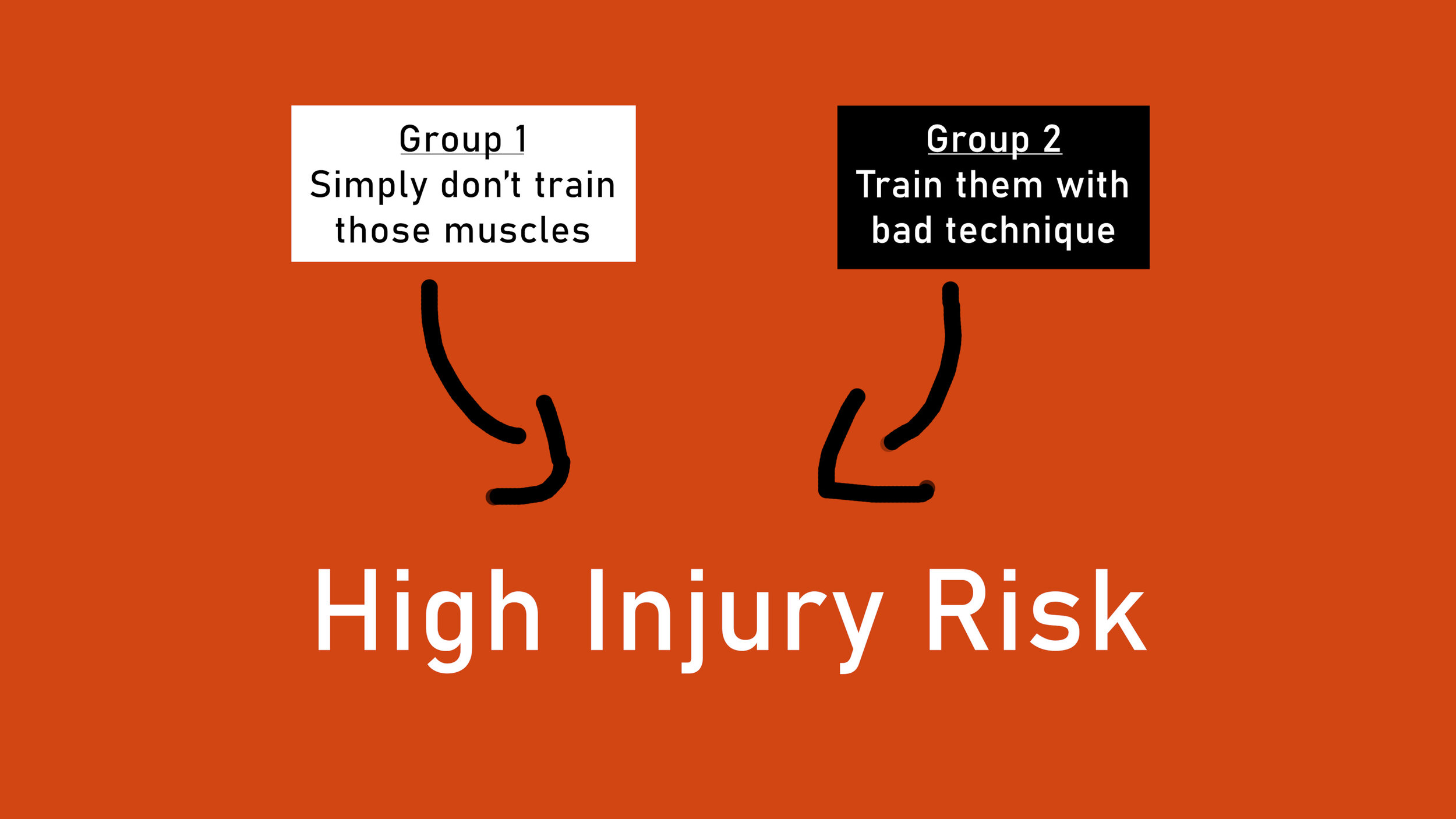How to NOT Get Injured Climbing (NO GYM - PRO’S ROUTINE)
Hooper’s Beta Ep. 72
Intro
There are specific muscles in the forearms, shoulders, core, and legs that are essential for climbing, yet many climbers are unsure how to train them properly. This usually leads to one of two things: they don’t train those muscles at all, or they do train them but with improper technique. Either way, the outcome is the same: high risk of injury when climbing.
So to solve this, I’ve created one simple workout routine to teach you how to train those muscles, fortify your body from injuries, and make you a stronger, more well-rounded climber. AND, you only have to do it once a week!
This workout consists of 12 exercises broken down into 3 circuits. So let’s jump right into it, and remember: you can find all this information and more written out in the show notes on our website!
Circuit #1
The first circuit starts with 15 repetitions of Bilateral external rotations with scap retraction. This exercise is helpful in promoting good external rotator strength and synergy with the scapular retractors. The most important tip here is to perform a good scapular retraction with each repetition, and to not rotate out too far to the side. If you find arms going too wide, simply choke up on the band and create more resistance.
The second exercise is 20 repetitions of Plank Shoulder taps. This works the core and the serratus anterior, and is also good antagonistic training. Start in a push up position and make sure your chest is pushing away from the ground, not collapsing down towards it. Feet should be slightly wider than hip width and hands narrow. Keep the core tight and tap the opposite shoulder. To make this easier, put your hands on a raised surface like a bench, counter, or wall. To make it harder, tap the thighs instead of the shoulders, add repetitions, or simply elevate your feet.
Alternate version: I know some of you are also in love with the idea of doing push ups, so, one fun variation is to perform a push up in between each shoulder tap.
The third exercise is 10 repetitions of Nordic hamstring Curls. This is super helpful in building heel hooking strength and teaches you good tension. Find something nice and soft such as a pillow or blanket, place it near a wall, and kneel on both legs. Back your feet up close to the wall so that your toes and heels are touching. Once you begin it is natural for your heels to come off the wall. Keep your body straight, and engage your core, glutes, and hamstrings as you start to lean forward. Keep the motion small initially and then as you feel stronger add in some variation:
Variation 1: Double leg with cross body reaches
Variation 2: single leg
Variation 3: single leg with cross body reaches
The 4th and final exercise of this circuit is 12 repetitions of Eccentric finger rolls. This is great for working the wrist flexors and the finger flexors, obviously an important part of climbing. An olympic bar works best here, but a dumbbell is okay too. A resistance band can work in a pinch but is less efficient as it will limit your range of motion. Start with the wrists flexed, slowly lower the weight down as the wrists extend, and then start to open the fingers, allowing the weight to roll down to the tip of the fingers, just before you feel like the weight will fall off your hand, then curl it all the way back up to the top. If using a dumbbell just be sure to avoid excess deviation of the wrist on the pinky side. A mild amount of deviation is fine, just don’t let it get extreme. If using a resistance band, you may need to do the two motions separately as the band won’t roll down the hand very well.
Once you have done 1 set of each exercise, take a short rest, and do it again! After that, move on to the next circuit.
Circuit #2
Our second circuit will follow the same pattern as the first: shoulders, core, legs, forearms.
We’ll start off with 12 repetitions of the W exercise, otherwise known as robbers, surrenders, giver uppers… etc. This is an advancement of the first exercise in circuit #1 and more functional training for the external rotators. The three keys are: 1) start by squeezing the shoulder blades together and down, don't shrug up. 2) the arms should be approximately 45-60 degrees out to the side. 3) imagine you are punching someone behind you with the band of your hand/fist.
The second exercise is 30-60 seconds of Side planking, based on your tolerance. This is helpful for the obliques which are important in creating stability while climbing, and it helps with basic shoulder stability. If you feel the basic side plank is too easy, here are some harder progressions:
Plank hold 30-60 seconds
Plank hold 30 seconds with hip dips x6-10
Plank hold __ seconds with hip dips x6 and leg lifts x4
Side plank with hip dip x2, leg lift x1, and reach through (all movements = 1 rep, 4-6 total reps)
The third exercise is 10 repetitions of Stiff leg RDL’s. This is a great exercise because it works the hamstring with the knee in an extended position, which is good for cave climbing, helping you pull into the wall. It’s great for those high or far heel hooks where the knee is straighter. With this movement, keep the knee relatively straight but not locked out, and hinge at the hip. Keep your shoulder blades pulled back and down, keep your core engaged, and hinge forward. Once you feel the pull in your hamstring, stop your descent, and use that pull to lift yourself back up as you “pull your hips through”. Some modifications on this include:
Reaching into multiple directions
Added weight
The 4th exercise of this circuit is 12 repetitions of Reverse curls . This is an excellent forearm and elbow exercise as it works the brachialis, brachioradialis, wrist extensors, and finger flexors. Winning! An olympic bar is best here but if you only have bands or free weights they will work, just be really aware of the position of your wrist. With an olympic bar, start with the thumb-over-bar position. This will work your finger flexors more. Curl the bar up and slowly back down. With a dumbbell, allow your elbow to drift about 15-20 degrees away from your body, start with your palm down, and curl up. The reason the elbow is not touching the body is to allow the elbow to move through the motion without supinating. We want to keep the wrist in pronation to work those extensors.
If using a band, same as the dumbbell.
Once you have done 1 set of each exercise, take a short rest, and do it again! After that, move on to the next circuit
Circuit #3
The first exercise in the third circuit is 10 repetitions of Face pulls. This is one of my favorites for the shoulders/upper back. This is great for working the external rotators in the 90/90 position, which is super functional for climbing and all overhead sports. A resistance band or pulley system works great for this. As you pull back, make sure to squeeze the shoulder blades down and back, and “punch the wall behind you” to make sure you get good external rotation. An advancement of this is to include an overhead press, which will really activate the lower trapezius.
The second exercise is 10 or more reps of Hollow rocks. This is in here to work the “front” core. And help us with cave climbing and getting our feet back on the wall. One of the most important aspects of this is maintaining good Transversus abdominis engagement, my favorite tip for success here is to think about “pulling on a tight pair of jeans” or “pull your belly button in towards your spine”. For good form, keep the legs straight, toes pointed, arms overhead, and keep the motions small. There are a couple modifications to make this easier, though. Keeping your knees bent and your arms at your chest will help, or just try one. Example: knees bent but arms overhead.
The third exercise is 10 repetitions of Sumo Squats. The sumo squat is a compound exercise designed to work the arms, core, glutes, and the hamstrings which is helpful in learning to control tension in the body and will also increase our anabolic hormones in the body, which means we will build strong healthy bodies and is critical for our next exercise. Start with a wide stance and the feet rotated out (legs in external rotation). Keep the chest more upright as you sit down into the squat. Squeeze the glutes as you press up, repeat. As for alternates, you can do a Romanian deadlift if you have the equipment and know the proper technique. In fact, that is actually the ideal exercise to do here, but since it’s a bit more complicated it’s best to start with the sumo squats unless you’re an experienced deadlifter.
The 4th final exercise of the last circuit is 5 repetitions per hand of Recruitment pulls @ moderate effort. The purpose of this is to work on healing and fortifying out fingers. This last circuit has some big body movements which should cause an increase in anabolic hormones in the body. We will take advantage of those hormones and direct some of them to our fingers by performing the recruitment pulls. To do this you’ll pick a ledge small enough that you can’t hang your full weight one-handed. Pull down on the ledge with increasing intensity, starting light and gradually increasing to 80% pull effort over a 5 second period.
Repeat this circuit 2-3 times through, and you’re done!
As for frequency and WHEN to perform this?
I recommend just once a week, unless these are significant issues for you, then try to do this twice a week. You can do it independently on a day off from climbing if it fits your schedule, or, I would recommend doing this on a moderate climbing day. Perhaps where you are working on technique and not doing limit climbing or projecting.
That’s it! A complete training circuit to help get stronger and prevent common climbing injuries. Now that you have done your TRAINING. Go out there and CLIMB things, SEND a few projects, and REPEAT next week!
For easy implementation for your training:
Circuit 1: 2-3x through
Bilateral external rotation with scap retraction “no money” x15
Plank Shoulder taps x20
Nordic hamstring Curls x10
Eccentric finger rolls
Circuit 2: 2-3x through
W’s
Side planks
Stiff leg RDL’s
Reverse curls
Circuit 3: 2-3x through
Face pulls / face pull with overhead press
Hollow rocks
Sumo Squats / Romanian Deadlifts
Recruitment pulls on small ledge @moderate effort [Alternate: hammer sup/pro]
Disclaimer:
As always, exercises are to be performed assuming your own risk and should not be done if you feel you are at risk for injury. See a medical professional if you have concerns before starting new exercises.
Written and Produced by Jason Hooper (PT, DPT, OCS, SCS, CAFS) and Emile Modesitt
IG: @hoopersbetaofficial



















